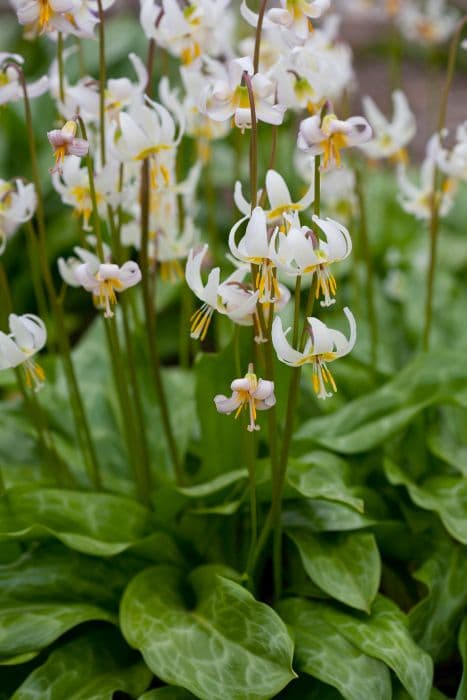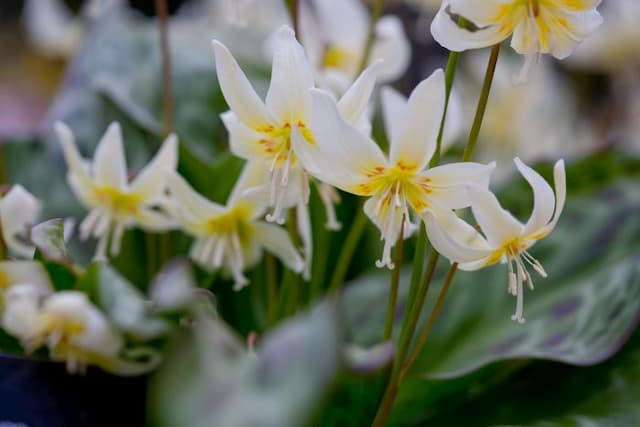Tulip Tulipa 'Abba' (2)

ABOUT
Tulipa 'Abba', known commonly as the tulip, is a perennial bulbous plant boasting strikingly bold flowers. Each bloom is cup-shaped, featuring a rich crimson hue with a velvety texture. The petals are edged with a fine margin of gold, adding contrast and highlighting the deep red. The flowers usually possess a glossy and shimmering appearance that catches the light and gives them a lustrous quality. The leaves of the tulip 'Abba' are lance-shaped and have a grayish-green color that provides a perfect backdrop to the dramatic flowers. These leaves are somewhat thick and fleshy, with a smooth surface and often appear in a rosette formation at the base of the plant. The stem of the flower is erect and sturdy, supporting the weight of the bloom above the foliage. Tulipa 'Abba' emanates a light fragrance, adding a sensory delight to its visual appeal. This tulip variety is often planted in groups or clusters, creating a dense swathe of color in the landscape. The vivid blooms make this tulip a popular choice for cut flower arrangements, where their showy petals and strong stems can be displayed prominently.
About this plant
 Names
NamesFamily
Liliaceae
Synonyms
Abba Tulip, Double Late Tulip, Peony Flowering Tulip
Common names
Tulipa 'Abba'
 Toxicity
ToxicityTo humans
Tulips, including the variety Tulipa 'Abba', contain compounds that can be toxic if large quantities of the plant, particularly the bulbs, are ingested. These compounds can cause symptoms such as nausea, vomiting, diarrhea, and irritation of the mouth and throat. If a substantial amount of tulip bulbs is consumed, more severe symptoms including an increased heart rate, changes in breathing, and even convulsions could potentially occur. It's important to seek medical attention if you suspect tulip poisoning.
To pets
Tulips, including the variety Tulipa 'Abba', contain allergenic lactones and other compounds that are toxic to pets. If pets, especially cats and dogs, consume parts of the tulip plant, particularly the bulbs, it can cause gastrointestinal upset including vomiting and diarrhea. In some cases, the ingestion might lead to drooling, depression, and an increased heart rate. It is particularly dangerous if large quantities of the bulb are eaten. If you suspect your pet has ingested tulip bulbs, it is important to contact your veterinarian immediately.
 Characteristics
CharacteristicsLife cycle
Perennials
Foliage type
Deciduous
Color of leaves
Green
Flower color
Red
Height
1-2 feet [30-60 cm]
Spread
3-6 inches [7.5-15 cm]
Plant type
Bulb
Hardiness zones
3
Native area
Central Asia
Benefits
 General Benefits
General Benefits- Spring Color: Tulip 'Abba' brings vibrant red blossoms to gardens, signaling the arrival of spring.
- Easy to Grow: This tulip variety is known for its ease of cultivation and ability to thrive in a variety of soil types.
- Garden Design: Its bold color and classic shape are excellent for creating striking garden displays.
- Cut Flowers: Tulipa 'Abba' is ideal for cut flower arrangements due to its sturdy stems and long vase life.
- Attracts Pollinators: The flowers can attract bees and other pollinators, supporting local ecosystems.
- Drought Tolerance: Once established, they exhibit a degree of drought tolerance, making them suitable for drier climates.
- Perennial Growth: As a perennial, it can provide years of beauty with proper care, often re-blooming annually.
- Low Maintenance: They require minimal care once planted, making them a good choice for busy gardeners.
 Medical Properties
Medical PropertiesThis plant is not used for medical purposes.
 Air-purifying Qualities
Air-purifying QualitiesThis plant is not specifically known for air purifying qualities.
 Other Uses
Other Uses- Tulipa 'Abba' bulbs can be crushed to make a natural glue due to the sticky substances they contain.
- The petals of the Tulip 'Abba' may be used in natural dyes for coloring fabrics or artworks.
- These tulips can be part of a sensory garden, addressing the needs of individuals with specific sensory processing issues by providing visual stimulation.
- The strong, vivid colors of Tulip 'Abba' are sometimes imitated in art and design projects as a natural color reference.
- In certain cultures, Tulip 'Abba' petals have been used as confetti at weddings and celebrations due to their vibrant color and biodegradability.
- The Tulip 'Abba' can be used in educational settings as a tool to teach botany and horticulture through hands-on gardening practices.
- Their structured form can inspire artists and architects who may incorporate the tulip's geometric aesthetic into their designs.
- Culinary experimentation with Tulip 'Abba' may involve using the edible parts as garnishes for elaborate dishes, though this should only be done with knowledge of safe, non-toxic varieties.
- Used in color-themed gardens to create visual impact or set a specific mood associated with its red hue.
- The Tulip 'Abba' can be part of ecological landscaping, attracting pollinators like bees and butterflies to gardens and supporting biodiversity.
Interesting Facts
 Feng Shui
Feng ShuiThe Tulip is not used in Feng Shui practice.
 Zodiac Sign Compitability
Zodiac Sign CompitabilityThe Tulip is not used in astrology practice.
 Plant Symbolism
Plant Symbolism- Perfect Love: Tulips in general symbolize perfect love, with their elegant and easily recognizable shape they're often associated with an idealistic love concept.
- Declaration of Love: Giving a tulip, such as Tulipa 'Abba', is seen as a declaration of one's true love, making it a popular choice for romantic occasions.
- Royalty: The lush, rich colors of some Tulipa 'Abba' varieties can represent royalty and a regal bearing, reflecting the flower's historical significance in royal courts.
- Prosperity: Due to their historical value during the Tulip Mania, tulips can symbolize prosperity and material wealth.
- Charity: In the Victorian language of flowers, a tulip may signify charity, as giving a tulip was seen as a generous and heartfelt gesture.
- Spring & Renewal: As one of the first flowers to bloom in spring, tulips, including Tulipa 'Abba', are symbols of new beginnings and the renewal that comes with springtime.
 Water
WaterFor tulips, typically watering is necessary when the soil feels dry to the touch. Early in the growth season, provide about one inch of water each week, especially if rainfall is less frequent. During active growth, you may increase watering slightly, but be cautious not to overwater as tulips are prone to rot if kept too wet. When the weather is particularly hot and dry, additional water may be needed, but always check the soil moisture first. After blooming, reduce watering to allow the foliage to die back naturally.
 Light
LightTulips thrive best in a spot that receives full to partial sunlight. They need at least 6 hours of direct sun each day to develop properly. The ideal location is an area that's sunny in the morning with some afternoon shade, as this helps protect the blooms from the intense heat of late-day sun.
 Temperature
TemperatureTulips prefer a temperate climate and perform best in regions with a cool spring and during the fall. They can survive winter temperatures as low as 20°F, and in the growing season, they flourish in temperatures between 60°F and 70°F. The bulbs require a period of winter chilling at temperatures between 35°F and 55°F to bloom in spring.
 Pruning
PruningPruning tulips isn't typically necessary, but you should remove the spent blooms after they have faded to prevent the plant from expending energy on seed production. Cut back the foliage only after it has yellowed and died down naturally, usually several weeks after flowering. The best time for removing dead flowers is soon after they've wilted.
 Cleaning
CleaningAs needed
 Soil
SoilTulips thrive in well-draining soil with a pH between 6.0 and 7.0. The best soil mix for tulips should incorporate equal parts of garden soil, compost, and sand to facilitate proper drainage. Avoid soil that retains excessive moisture, as this can cause the bulbs to rot.
 Repotting
RepottingTulips, as perennial bulbs, do not require frequent repotting. They should be replanted yearly after the foliage has died back and the bulb has been dormant, typically in the fall. Ensure fresh, fertile soil is used each time to maintain nutrient levels.
 Humidity & Misting
Humidity & MistingTulips prefer a moderate outdoor climate and do not require high humidity levels. They are quite adaptable but should not be subjected to extremely high humidity as it may promote fungal diseases. Providing good air circulation helps maintain appropriate humidity levels around the plants.
 Suitable locations
Suitable locationsIndoor
Plant in a cool, sunny spot with well-draining soil and chill bulbs beforehand.
Outdoor
Plant bulbs in fall, in well-draining soil, full sun to partial shade.
Hardiness zone
3-8 USDA
 Life cycle
Life cycleTulipa 'Abba', commonly known as Double Early Tulip, begins its life cycle as a bulb planted in the fall before the frost. During the winter, the bulb undergoes a chilling period which is essential for spring growth. Come early spring, the bulb sends up green shoots and leaves, followed by stems that produce double, brightly colored red flowers. After blooming, typically in mid-spring, the flowers eventually wither, and the plant focuses on energy storage back in the bulb. Throughout the summer, the foliage dies back, and the bulb goes dormant. The cycle restarts when the bulb is again subjected to cooler temperatures in the ensuing fall.
 Propogation
PropogationPropogation time
Spring
Tulipa 'Abba', commonly known as tulip 'Abba', is propagated by dividing and replanting its bulbs. The best time to do this is in the late summer or early fall, after the foliage has died back but before the ground freezes. To propagate, dig up the mature bulbs carefully and gently separate the smaller offset bulbs that have formed around the base of the mother bulb. These offsets, or daughter bulbs, can be replanted immediately at a depth of about 6 to 8 inches (15-20 centimeters) and spaced about 4 to 6 inches (10-15 centimeters) apart. Choose a well-draining spot with full sun, as tulips thrive in plenty of light. With proper care, these offsets will grow into new flowers in the following spring.








